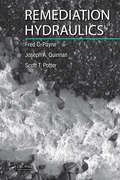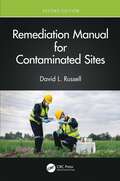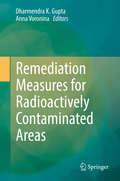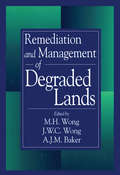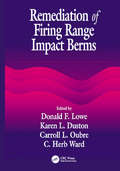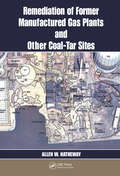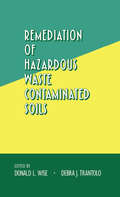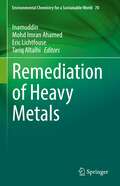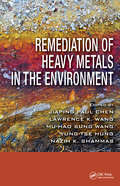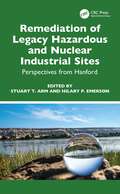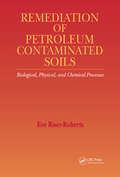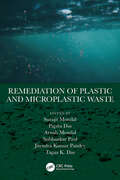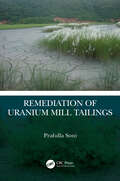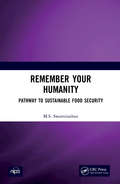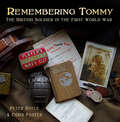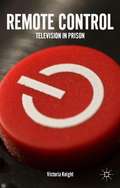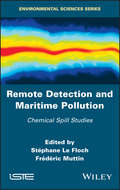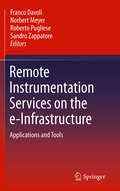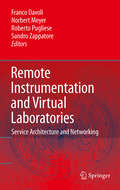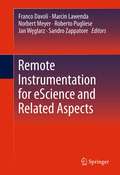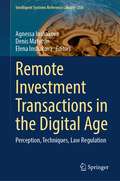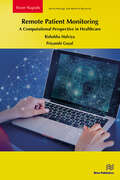- Table View
- List View
Remediation Hydraulics
by Fred C. Payne Joseph A. Quinnan Scott T. PotterIn situ treatments involving the arrangement of contact between prospective reactants in complex porous media require a refined understanding of solute migration. However, the tools and methods used to predict and control fluid movement in the subsurface need significant improvement. Practitioners and regulators must develop novel methods to
Remediation Manual for Contaminated Sites
by David L. RussellBased on the author’s more than 40 years of experience working on environmental projects, Remediation Manual for Contaminated Sites provides a practical guide to environmental remediation and cleanups. It presents a broad overview of the environmental remediation process, distilled into what one needs to know to evaluate a specific challenge or solve a remediation problem. The text offers guidance on tasks that range from managing consultants and contractors to gathering data, selecting a suitable remediation technology, and calculating remediation costs. This new edition is updated throughout, includes five new chapters, and provides a more global coverage.• This book includes remediation strategies for a variety of contaminants and examines a wide range of technologies for the remediation of water and soil, including excavation, wells, drainage, soil venting, vapor stripping, incineration, bioremediation, containment, solidification, vitrification, and phytoremediation.• Written as a down‑to‑earth reference for professionals faced with the challenges of remediating a contaminated site, this book is also useful as a primer for students and those new to the field. It includes numerous figures, photographs, tables, and helpful checklists.• This new edition adds five all‑new chapters. It presents a more global approach and practical examples from around the world.
Remediation Measures for Radioactively Contaminated Areas
by Dharmendra K. Gupta Anna VoroninaThis book offers extensive and comprehensive knowledge to the researchers and academicians who are working on decontamination of radioactively contaminated areas. Remediation strategies for contaminated sites are provided. Readers who will find this book useful include professionals specializing in radioecology, safe disposal of radioactive waste, as well as decontamination, remediation legacies and impact of radioactive waste material on the environment. The chapters give a broad overview and reviews of a number of original publications on remediation strategies that were explored after the Chernobyl and Fukushima Nuclear Power plant accidents. Useful case studies are provided that explore the latest technological developments and future trends for affected area decontamination.
Remediation and Management of Degraded Lands
by MH WongRemediation and Management of Degraded Lands presents the program of the first International Conference on the Remediation and Management of Degraded Lands. This collection reviews the extent of resource debasement and offers solutions for their restoration. The 14-part first section deals with mine management and rehabilitation. Topics include the devastating results of open-cut mining, open-pit mining, lignite surface mining and acid mining. Despite such ruin, the articles reveal the possibilities for reclamation. Part two devotes nine chapters to the management of derelict lands. Reforestation, soil fertility prognosis, and the uses of nitrogen are just a few of the covered subjects. This portion of the book pays special attention to the successful results of remediation in China and Hong Kong. The final division addresses soil contamination and reclamation. There are eleven chapters on subjects that include the single and interactive effects of aluminum, the effectiveness of EDTA/HCI and the value of pig-on-litter compost as a tool for edible crop growth. These and other innovative techniques make Remediation and Management of Degraded Lands a valuable addition to any environmental library.
Remediation of Firing Range Impact Berms
by C. H. WardA part of the continuing effort to provide innovative in situ remediation techniques, Remediation of Firing-Range Impact Berms presents the results of a soil washing and leaching project. The demonstration set as its primary objective providing reliable, detailed performance data to evaluate the feasibility and cost of implementing a full-scale sys
Remediation of Former Manufactured Gas Plants and Other Coal-Tar Sites
by Allen W. HathewayWinner of the 2013 Claire P. Holdredge Awardee for Remediation of Former Manufactured Gas Plants and Other Coal-Tar Sites.This award, first established in 1962 by the Association of Environmental and Engineering Geologists, is named in honor of Claire P. Holdredge, a founding member and the first President of the Association. The award is
Remediation of Hazardous Waste Contaminated Soils
by DonaldL. Wise""This unique, single-source reference offers a thorough treatment of the remediation of soils contaminated by hazardous wastes and the scientific and engineering issues that must be addressed in creating practical solutions for their reclamation.
Remediation of Heavy Metals (Environmental Chemistry for a Sustainable World #70)
by Eric Lichtfouse Inamuddin Mohd Imran Ahamed Tariq AltalhiThe book presents recent remediation techniques for heavy metal contamination in wastewater, with a focus on recently-developed and sustainable materials such as metal oxides and their composites, two-dimensional materials, organic-inorganic ion exchange materials, nanomaterials, bagasse, and olive-oil waste chelating materials. Chapters also describe the analysis of heavy metals, membranes for water treatment, sources and impact of heavy metals and opportunities and challenges in heavy metal remediation.
Remediation of Heavy Metals in the Environment (Advances in Industrial and Hazardous Wastes Treatment)
by Lawrence K. Wang Yung-Tse Hung Nazih K. Shammas Jiaping Paul Chen Mu-Hao Sung WangThis book provides in-depth coverage of environmental pollution sources, waste characteristics, control technologies, management strategies, facility innovations, process alternatives, costs, case histories, effluent standards, and future trends in waste treatment processes. It delineates methodologies, technologies, and the regional and global effects of important pollution control practices. It focuses on toxic heavy metals in the environment, various heavy metal decontamination technologies, brownfield restoration, and industrial, agricultural, and radioactive waste management. It discusses the importance of metals such as lead, chromium, cadmium, zinc, copper, nickel, iron, and mercury.
Remediation of Legacy Hazardous and Nuclear Industrial Sites: Perspectives from Hanford
by Stuart T. Arm Hilary P. EmersonRemediation of Legacy Hazardous and Nuclear Industrial Sites provides an overview of the key elements involved in remediating complex waste sites using the Hanford nuclear site as a case study. Hanford is one of the most complex waste sites in the world and has examples of most, if not all, characteristics of the complex waste sites that exist globally. This book is aimed at a non-technical audience and describes the stages of remediation based on general RCRA/CERCLA processes, from establishing a strategy that includes all stakeholders to site assessment, waste treatment and disposal, and long-term monitoring.Features: Informs a non-technical audience of the important elements involved in complex waste site remediation Employs the Hanford Site as a case study throughout to explain real-world applications of remediation steps Connects the “human” element to the technical aspects through interviews with key current and retired individuals at the Hanford Site Includes discussion of stakeholders and the engagement process in remediation Demonstrates how all elements of complex waste site remediation from demolition of buildings to groundwater management are interrelated Focuses on broader technical and sociopolitical challenges for remediation of a contaminated site Aimed at a broad audience, this book offers approachable guidance to technical and non-technical readers through a series of real-world examples that cover each important step in the complex waste cleanup process.
Remediation of Petroleum Contaminated Soils: Biological, Physical, and Chemical Processes
by Eve Riser-RobertsThis book combines the results of current research with essential background material to provide complete, in-depth coverage of every aspect of in situ and ex situ bioremediation, as well as an extensive overview of the physical and chemical processes currently available for treating petroleum-contaminated soils. Critical information has been collected and assembled under one cover to provide a convenient reference for anyone who must contend with this worldwide problem.Remediation of Petroleum Contaminated Soils: Biological, Physical, and Chemical Processes describes how to optimize the biodegradation of petroleum hydrocarbons in soil-water systems. It reports on the susceptibility of various petroleum components to biodegradation by microorganisms, and considers all groups of microorganisms for their potential contributions. The book also deals with problem areas such as the transport of organisms, oxygen, or nutrients throughout the subsurface, as well as biodegradation of polynuclear aromatic hydrocarbons (PAHs) and nonaqueous phase liquids (NAPLs). In addition, the book presents a variety of methods for monitoring bioremediation.This reference discusses current soil remediation processes and includes many innovative approaches. It also investigates means of controlling volatile organic compounds (VOCs) and leachate, and addresses methods for collecting and treating these secondary waste streams. The expansive coverage of this book will furnish readers with a wide range of options for developing treatment strategies and for customizing procedures for specific requirements.
Remediation of Plastic and Microplastic Waste
by Jitendra Kumar Pandey Tapas K. Das Surajit Mondal Papita Das Arnab Mondal Subhankar PaulThis book provides recent developments and advancements in management of plastic wastes and associated challenges with it. It primarily addresses the issues of plastics that might drastically affect the lifeform in the long run and its prevention by introducing appropriate alternatives and/or finding strategies to mitigate the existing microplastic crisis using suitable approaches. It focusses on efforts on neutralizing and restricting further spread of microplastic pollution, its bioaccumulation and associated human health impacts. Features: Covers technological mitigation of plastics and microplastic wastes along with their remediation in a technical manner. Discusses advances in plastic and micro-/nano-plastic pollution and possible pathways of pollution. Demonstrates the mitigation measures to minimize such pollution loads, with a special focus on the application of nanotechnology. Reviews recycle and value-added products from the waste plastic. Focusses on development of alternate clean energy sources. This book is aimed at researchers and graduate students in environmental and chemical engineering and remediation.
Remediation of Uranium Mill Tailings
by Prafulla SoniThis book covers issues pertaining to uranium tailings with special reference to consolidation of radioactivity including systematic ecological strategy for consolidation of radionuclides in uranium tailings. It discusses sustainable consolidation of radioactivity and checks the migration of unextracted uranium from tailing piles to plants and atmosphere supported by a case study from a uranium mine. It provides simple ecological solutions for the remediation of radioactivity in mill tailings. Features: Provides insight into the application of applied ecology for bioremediation of radioactive wastes. Discusses species selection criteria for tailings radioactivity consolidation. Explains safe treatment of the tailings of radioactive ore processing plants. Illustrates the role of ethnobotany in the selection of the most appropriate species to effectively use in bioremediation. Focuses on experimental outcomes. This book is aimed at researchers and professionals in mining engineering, applied geology, nuclear tailings and environmental protection.
Remember
by Eileen CookA thrilling tale about what a girl will do to get back a memory she lost...or remove what she wants to forget.Harper is used to her family being hounded by protestors. Her father runs the company that trademarked the "Memtex" procedure to wipe away sad memories, and plenty of people think it shouldn't be legal. Then a new demonstrator crosses her path, Neil, who's as persistent as he is hot. Not that Harper's noticing, since she already has a boyfriend. When Harper suffers a loss, she's shocked her father won't allow her to get the treatment, so she finds a way to get it without his approval. Soon afterward, she's plagued with strange symptoms, including hallucinations of a woman who is somehow both a stranger, yet incredibly familiar. Harper begins to wonder if she is delusional, or if these are somehow memories. Together with Neil, who insists he has his own reasons for needing answers about the real dangers of Memtex, Harper begins her search for the truth. What she finds could uproot all she's ever believed about her life...
Remember Your Humanity: Pathway to Sustainable Food Security
by M.S. SwaminathanA well-known writer and speaker in forums all over the world, a list of Dr. Swaminathan’s writings and speeches goes to over 50 . This book collects together some of his more recent observations, edited for publication. It is evident from the range of issues discussed that the author’s mission in life is to foster a movement of hope and peace by eradicating hunger and poverty, for humankind to live in harmony with nature. Swaminathan stresses that sustainable development must be firmly rooted in the principles of ecology, social and gender equity, employment generation, and economic potential.Note: T&F does not sell or distribute the hardback in India, Pakistan, Nepal, Bhutan, Bangladesh and Sri Lanka. This title is co-published with NIPA.
Remembering Tommy: The British Soldier in the First World War
by Peter Doyle Chris FosterThe British soldier of the Great War has been depicted in many books. Invariably, a pen picture paints him as stoic, joining the army in a wave of patriotic fervour, and destined to serve four years on the Western Front in some of the most costly battles in history. Yet often the picture is difficult to resolve for the reader. What was it like in the trenches? How did the soldier live, where did he sleep? What was it like to go over the top, and when he did, what did he carry with him? For many, the idea of trench life is hazy, and usually involves ‘drowning in mud’, in, as one writer put it, ‘the pitiless misery’ of Passchendaele. Recently, military historians have presented an alternative picture, a picture in which the hopelessness of the First World War is given new life and purpose. Remembering Tommy pays tribute to the real life British soldier of the Great War from the moment of joining up to their final homecoming. Using original artefacts in historic settings, the men and their words are brought to life. The uniforms they wore, the equipment they carried, the letters they wrote home, their personal possessions, mementos and photographs come together in a powerful tribute to the indomitable Tommy. Each one of these precious artefacts bears witness to the men who left them behind – allowing us to almost reach out and touch history.
Remembering You: Cuando tus recuerdos me encuentren
by Vee PolluxUna leyenda más antigua que el universo dice que no hay fuerza en el mundo que pueda separar dos almas hechas del mismo cosmos. Noah no entendía lo que le estaba ocurriendo. Cada vez que salía de casa, veía al chico de la chaqueta vaquera de pie en medio de la calle. Cuando estaba en el trabajo, una imagen suya aparecía en los reflejos de todos los espejos. Pensó que todas las alucinaciones tenían que ver con el hecho de que se estaba volviendo loco. La realidad ya empezaba a mezclarse, y Noah ya no sabía en cuál de ellas vivía realmente. ¿Y si todo eso no es más que una ilusión de su cabeza?
Remembrance of Things Present: The Invention of the Time Capsule
by Nick YablonTime capsules offer unexpected insights into how people view their own time, place, and culture, as well as their duties to future generations. Remembrance of Things Present traces the birth of this device to the Gilded Age, when growing urban volatility prompted doubts about how the period would be remembered—or if it would be remembered at all. Yablon details how diverse Americans – from presidents and mayors to advocates for the rights of women, blacks, and workers – constructed prospective memories of their present. They did so by contributing not just written testimony to time capsules but also sources that historians and archivists considered illegitimate, such as photographs, phonograph records, films, and everyday artifacts. By offering a direct line to posterity, time capsules stimulated various hopes for the future. Remembrance of Things Present delves into these treasure chests to unearth those forgotten futures.
Remote Control: Television in Prison
by Victoria KnightIn-cell television is now a permanent feature of prisons in England and Wales, and a key part of the experience of modern incarceration. This sociological exploration of prisoners' use of television offers an engaging and thought provoking insight into the domestic and everyday lives of people in prison - with television close at hand. Victoria Knight explores how television contributes to imprisonment by normalising the prison cell. In doing so it legitimates this space to hold prisoners for long periods of time, typically without structured activity. As a consequence, television's place in the modern prison has also come to represent an unanticipated resource in the package of care for prisoners.
Remote Detection and Maritime Pollution: Chemical Spill Studies
by Frédéric Muttin Stéphane Le FlochThe detection of marine pollution requires a scientific and operational response to identify contaminants, chemicals and hydrocarbons, and to support contrasting observations. Remote Detection and Maritime Pollution originates from the proceedings of CEDRE Information Day, held on October 13, 2016 in Brest, France. Containing four parts encompassing 13 chapters, this book explores remote detection channels for the multiform marine pollutions of today and of the future. With a focus on transatlantic cooperation, it covers remote detection sensors, the state of the art of maritime surveillance with regard to the interests of national and international authorities, the benefits of response strategy, and geophysical exploration. Future vectors (airplanes, drones, satellites, among others) and sensors (radar, optical, hyperspectral and so on) are also studied. This book is a valuable resource for practical solutions for marine authorities, industries (chemical, energy, aerospace, petroleum, shipping), lawyers and scientists.
Remote Instrumentation Services on the e-Infrastructure
by Roberto Pugliese Norbert Meyer Franco Davoli Sandro ZappatoreThe book focuses on all aspects related to the effective exploitation of remote instrumentation and to the building of complex virtual laboratories on top of real devices and infrastructures. These include service oriented architecture (SOA) and related middleware, high-speed networking in support of Grid applications, wireless Grids for acquisition devices and sensor networks, Quality Service (QoS) provisioning for real-time control, measurement instrumentation and methodology, as well as metrology issues in distributed systems.
Remote Instrumentation and Virtual Laboratories
by Roberto Pugliese Norbert Meyer Franco Davoli Sandro ZappatoreAccessing remote instrumentation worldwide is one of the goals of e-Science. The task of enabling the execution of complex experiments that involve the use of distributed scientific instruments must be supported by a number of different architectural domains, which inter-work in a coordinated fashion to provide the necessary functionality. These domains embrace the physical instruments, the communication network interconnecting the distributed systems, the service oriented abstractions and their middleware. The Grid paradigm (or, more generally, the Service Oriented Architecture -- SOA), viewed as a tool for the integration of distributed resources, plays a significant role, not only to manage computational aspects, but increasingly as an aggregator of measurement instrumentation and pervasive large-scale data acquisition platforms. In this context, the functionality of a SOA allows managing, maintaining and exploiting heterogeneous instrumentation and acquisition devices in a unified way, by providing standardized interfaces and common working environments to their users, but the peculiar aspects of dealing with real instruments of widely different categories may add new functional requirements to this scenario. On the other hand, the growing transport capacity of core and access networks allows data transfer at unprecedented speed, but new challenges arise from wireless access, wireless sensor networks, and the traversal of heterogeneous network domains. The book focuses on all aspects related to the effective exploitation of remote instrumentation and to the building complex virtual laboratories on top of real devices and infrastructures. These include SOA and related middleware, high-speed networking in support of Grid applications, wireless Grids for acquisition devices and sensor networks, Quality of Service (QoS) provisioning for real-time control, measurement instrumentation and methodology, as well as metrology issues in distributed systems.
Remote Instrumentation for eScience and Related Aspects
by Roberto Pugliese Norbert Meyer Franco Davoli Sandro Zappatore Jan Węglarz Marcin LawendaThis book will focus on new Remote Instrumentation aspects related to middleware architecture, high-speed networking, wireless Grid for acquisition devices and sensor networks, QoS provisioning for real-time control, measurement instrumentation and methodology. Moreover, it will provide knowledge about the automation of mechanisms oriented to accompanying processes that are usually performed by a human. Another important point of this book is focusing on the future trends concerning Remote Instrumentation systems development and actions related to standardization of remote instrumentation mechanisms.
Remote Investment Transactions in the Digital Age: Perception, Techniques, Law Regulation (Intelligent Systems Reference Library #250)
by Agnessa Inshakova Denis Matytsin Elena InshakovaThe book contains the results of the best research developments obtained during the implementation of major scientific events organized and carried out with the financial support of the Russian Science Foundation and the President of the Russian Federation.The scientific novelty of the work lies in the fact that for the first time at the level of Russian and international interdisciplinary social and humanitarian sciences, primarily economic and legal, firstly, philosophical concepts and regulatory legal approaches to the regulation of remote investment transactions have been studied; secondly, a set of economic and legal conditions and means of harmonizing and observing the mutual interests of participants in remote investment transactions has been developed and proposed in order to prevent and minimize potential conflicts between the parties; thirdly, the current state and international regulation of investment transactions concluded and executed on Internet platforms was critically assessed; fourthly, a system of guarantees and protection of the rights of participants in remote investment transactions is proposed, including special contractual structures and an economic and legal model for the proper fulfillment of obligations.Measures are substantiated to expand and increase the intensity of the national investment turnover based on the improvement of the current legislation regulating investments through remote digital technologies in the Internet space, which provided a solution to the world scientific problem of great socioeconomic and economic importance. The book is designed for a wide target audience—scientists of different generations, different disciplinary and industry affiliations. Among them are young researchers, as well as scientists who have received recognition from the world scientific community, studying the socioeconomic, managerial, and legal consequences of the emergence and spread of digital technologies in the field of investment. Readers can be all individuals and legal entities interested in the development of digital technologies in the field of investment.
Remote Patient Monitoring: A Computational Perspective in Healthcare (River Publishers Rapids Series in Biotechnology and Medical Research)
by Rishabha Malviya Priyanshi GoyalThis book provides a multidisciplinary overview of the design and implementation of systems for remote patient monitoring and healthcare. Readers are guided through the components of such a system and shown how they could be integrated into a coherent framework for deployment in practice. The book ends with a discussion of case studies to provide practical examples and design methods for remote healthcare systems with different needs. This book contains information that will be helpful to undergraduate and postgraduate students, academic and professional researchers, and individuals who employ computational intelligence. By presenting new models of care and support, AI in medicine is having an impact on the entire value chain of clinical practice and the patient care delivery system. This is especially evident in telemedicine breakthroughs, where applications of AI are utilized to assist, complement, or create new forms of remote healthcare. Through the use of communications technology, telemedicine enables medical professionals to examine, diagnose, and treat patients remotely. Now, the technology might also integrate online diagnostics, etc., to increase the effectiveness of the healthcare system and enhance patient outcomes. By enabling elderly people to live independently, technological advancements in fields like remote patient monitoring (RPM) systems can revolutionize senior care. Medical diagnosis will improve, and remote patient monitoring will become simpler thanks to artificial intelligence. The resistance of many patients and doctors to using the telemedicine idea for medical visits will probably be overcome by AI automation.
